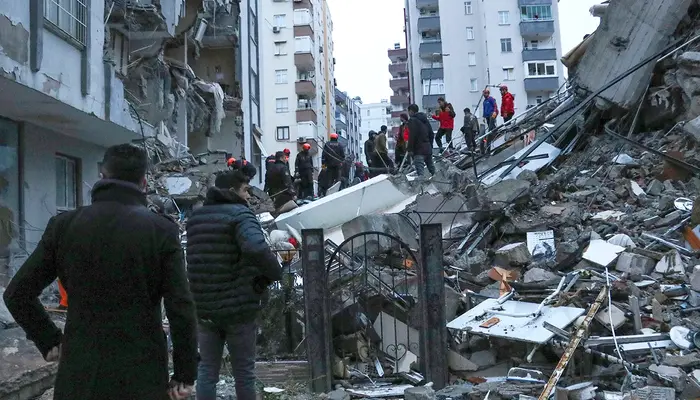One person has died after a magnitude 6.1 Balikesir earthquake struck north-west Turkey on Sunday evening, collapsing multiple buildings and injuring dozens.
Authorities confirmed that an 81-year-old woman passed away shortly after being pulled from the rubble in Sindirgi, the epicentre of the quake. Interior Minister Ali Yerlikaya said the woman was rescued alive but could not survive her injuries.
Widespread Damage in Sindirgi
The earthquake caused 16 buildings to collapse and injured 29 people, according to the interior minister.
Turkey’s Disaster and Emergency Management Authority (AFAD) reported that the tremors were recorded at 19:53 local time (16:53 GMT) and were felt as far away as Istanbul, more than 200 kilometres from the epicentre.
Images from the disaster zone show towering piles of twisted metal, crumbled concrete, and flattened residential blocks. Emergency workers were seen combing through debris under the harsh glow of spotlights, searching for survivors before concluding operations.
Government Responds to Crisis
President Recep Tayyip Erdogan issued a statement on social media platform X, expressing sympathy and pledging swift recovery measures for the affected areas.
“May God protect our country from any kind of disaster,” Erdogan wrote, adding that all recovery operations were being closely monitored.
The president confirmed that search and rescue efforts have now concluded, with no other signs of serious casualties or major damage outside of Sindirgi.
Seismic Activity Felt Across the Region
The Balikesir earthquake sent tremors across north-west Turkey, rattling homes and prompting panic in several provinces. Residents in Istanbul reported feeling buildings sway, though no significant damage was recorded there.
Balikesir Governor’s Office confirmed that local hospitals had been placed on high alert to treat the injured, and emergency shelters were set up for those whose homes were destroyed or deemed unsafe.
A Nation All Too Familiar with Earthquakes
Türkiye lies at the intersection of the Anatolian, Eurasian, and African tectonic plates, making it one of the most earthquake-prone countries in the world.
This latest disaster comes just over two years after the February 2023 earthquakes, which claimed more than 50,000 lives in Turkey and an additional 5,000 in neighbouring Syria. That 7.8-magnitude quake devastated the country’s southeast, leaving hundreds of thousands displaced.
The memory of that tragedy remains raw, and Sunday’s Balikesir earthquake has reignited concerns over building safety and disaster preparedness.
Read more: Climate Change Is Killing Fireflies, Threatening a US Summer Ritual
Survivors Recall the Moments of Panic
Local residents described scenes of chaos as the ground shook violently.
“We were sitting at home when everything started rattling,” said Mehmet Kaya, a Sindirgi shop owner. “We rushed outside, and within seconds we saw buildings collapsing.”
Others spoke of scrambling to rescue neighbours trapped under debris while fearing aftershocks. Emergency workers warned residents not to re-enter damaged buildings until safety inspections are complete.
Search and Rescue Operations Wrap Up
By Monday morning, the interior minister announced that all search and rescue operations in Sindirgi had ended. Teams confirmed there were no additional victims trapped in the rubble.
Heavy machinery is now being deployed to clear debris, while engineers assess structural damage in surrounding towns. The government has promised financial aid for reconstruction, prioritising homes for those left homeless.
International Community Sends Support
Several countries have expressed solidarity with Turkey following the Balikesir earthquake. Messages of sympathy poured in from neighbouring Greece, the European Union, and the United Nations. Humanitarian agencies have offered logistical assistance should Turkey require additional support.
Ongoing Recovery and Preparedness
Experts warn that earthquakes of similar or greater magnitude remain a persistent threat in Turkey’s seismic zones. The Kandilli Observatory and Earthquake Research Institute urged authorities to enforce stricter building codes to prevent large-scale casualties in future quakes.
For the residents of Sindirgi, the road to recovery will be long. The local municipality has set up temporary housing facilities, and volunteers are distributing food, blankets, and medical supplies.
The Balikesir earthquake has once again highlighted Turkey’s vulnerability to seismic disasters. While Sunday’s tremor was not as devastating as past events, it caused tragic loss of life and left dozens injured. For many survivors, the quake brought back painful memories of previous disasters, underscoring the urgent need for continued investment in disaster preparedness and resilient infrastructure.
Follow us on Instagram, YouTube, Facebook,, X and TikTok for latest updates
